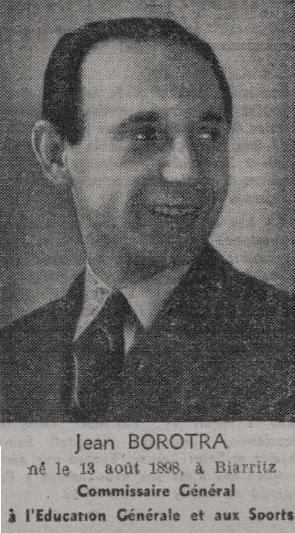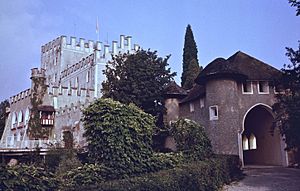Battle of Castle Itter facts for kids
The Battle of Castle Itter was a unique and surprising fight that happened on May 5, 1945, in a small Austrian village called Itter. It took place during the very last days of World War II in Europe. What makes this battle so special is that American soldiers, German soldiers who had switched sides, and French prisoners of war fought together against a group of loyal Nazi SS troops. Many people call it the "strangest battle" of World War II because former enemies joined forces.
The battle involved troops from the American 12th Armored Division, led by Lieut. John C. "Jack" Lee, Jr. They were joined by a group of German soldiers led by Major Josef Gangl, an SS officer named Kurt-Siegfried Schrader, and the French prisoners themselves. They all defended Castle Itter against an attack from the 17th SS Panzergrenadier Division. The defenders held out until more American soldiers from the 142nd Infantry Regiment arrived to help. The French prisoners held at the castle were very important people, including former prime ministers, famous generals, a tennis star named Jean Borotra, and even the sister of Charles de Gaulle, who would later become the leader of France.
Quick facts for kids Battle of Castle Itter |
|||||||
|---|---|---|---|---|---|---|---|
| Part of the Western Front of World War II | |||||||
 Itter Castle in 1979 |
|||||||
|
|||||||
| Belligerents | |||||||
|
|
||||||
| Commanders and leaders | |||||||
|
|||||||
| Units involved | |||||||
| Strength | |||||||
| 36 personnel 4 tanks |
150–200 personnel 3 flak guns |
||||||
| Casualties and losses | |||||||
| 1 killed and 4 wounded 1 tank destroyed |
Unknown killed and wounded 100 captured |
||||||
Contents
Why Was Itter Castle Important?
Itter Castle is a small castle located on a hill near the village of Itter in Austria. In 1938, Germany took control of Austria. After this, the German government rented the castle in late 1940.
Later, in 1943, the castle was taken over by the SS, a powerful Nazi organization. They turned it into a special prison. This prison was used to hold very important French prisoners who were valuable to the Nazi regime. These prisoners included famous people like tennis player Jean Borotra, and former French leaders such as Édouard Daladier and Paul Reynaud. Also held there were military commanders like Maxime Weygand and Maurice Gamelin, and even Charles de Gaulle's older sister, Marie-Agnès Cailliau. Besides these VIPs, the castle also had some Eastern European prisoners who did maintenance work.
How the Rescue Mission Started

As World War II was ending, things at the castle started to change. On May 3, 1945, a Yugoslav prisoner named Zvonimir Čučković, who worked as a handyman, secretly left the castle. He carried a letter in English asking for help from the Allied forces. He walked about 5 miles (8 km) down the mountains towards the town of Wörgl, which was still occupied by German troops. Čučković decided to keep going towards Innsbruck, about 40 miles (64 km) away. Late that night, he found an American army group and told them about the prisoners at the castle.
The next morning, the Americans tried to send a rescue team, but they were stopped by heavy gunfire. They were also told to turn back because they had entered an area assigned to another American division. Only two small jeeps continued.
When Čučković didn't return, and the prison commander Sebastian Wimmer feared for his life, the SS guards left the castle. The prisoners then took control and armed themselves with any weapons left behind. However, they were worried about attacks from other SS groups still loyal to the Nazis.
Since they didn't know if Čučković's mission worked, the prisoners asked their Czech cook, Andreas Krobot, to try to get help. On May 4, Krobot rode his bicycle to Wörgl. He found Austrian resistance fighters there, who then took him to Major Josef Gangl. Major Gangl was a German army officer who had refused to retreat and was now working with the local resistance. Gangl wanted to protect the people of Wörgl from the SS, who were still shooting at anyone showing a white or Austrian flag. Gangl hoped the Americans would arrive soon so he could surrender to them. Instead, he now had to ask them for help.
Around the same time, a group of four American Sherman tanks, led by Lieut. Lee, reached Kufstein, about 8 miles (13 km) north of Itter. When Gangl asked for help, Lee immediately volunteered to lead a rescue mission. After checking out the castle with Gangl, Lee decided to take 14 American soldiers, Gangl, his driver, and a truck with ten former German artillerymen. On their way, they had to send back some extra tanks and soldiers because a bridge was too weak to cross. About 4 miles (6 km) from the castle, they fought off some SS troops trying to block the road.
Meanwhile, the French prisoners had asked an SS officer named Kurt-Siegfried Schrader, whom they knew, to help with their defense. When Lee arrived at the castle, the prisoners were happy to see the Americans, but also a bit disappointed by how few soldiers there were. Lee quickly set up defenses around the castle and placed his Sherman tank, named Besotten Jenny, at the main entrance.
The Battle Begins
Soon after the American and German soldiers arrived, a force of 100–150 Waffen-SS soldiers, led by Georg Bochmann, launched an attack. Lieut. Lee had told the French prisoners to hide, but they bravely stayed outside and fought alongside the American and German soldiers. Throughout the night, the SS troops tried to find weak spots in the castle's defenses. Before the main attack, Major Gangl managed to call Alois Mayr, the Austrian resistance leader in Wörgl, asking for more help. Only two more German soldiers and a teenage Austrian resistance member named Hans Waltl could come, and they quickly drove to the castle.
On the morning of May 5, the full attack began. The Sherman tank fired its machine gun to help defend the castle until it was hit and destroyed by an 88 mm German gun. Luckily, the radioman inside escaped without injury.
By early afternoon, the American 142nd Regiment finally learned how desperate the situation was at the castle, and a relief force was sent. Lieut. Lee knew he couldn't give the 142nd all the information they needed because communications were cut. So, the famous tennis star Jean Borotra offered to jump over the castle wall and run through the SS positions to deliver the message. A French Canadian reporter with the 142nd recognized Borotra. Borotra asked for an American military uniform and then joined the relief force as they rushed to the castle before the defenders ran out of ammunition.
The relief force arrived around 4:00 PM, and the SS attackers were quickly defeated. About 100 SS soldiers were captured. The French prisoners were safely taken away that evening and reached Paris on May 10.
What Happened After
For his bravery in defending the castle, Lieut. Lee was promoted to Captain and received a special award called the Distinguished Service Cross. He passed away in 1973.
Major Gangl, the German officer who helped the Americans, was killed during the battle. He died while trying to move former French Prime Minister Paul Reynaud out of danger. Major Gangl is honored as an Austrian national hero, and a street in Wörgl was named after him. He was the only defender who died in the battle, though four others were wounded. This incredible event remains one of the most unusual stories from World War II.
See also
- Myth of the clean Wehrmacht
Images for kids
-
French tennis star Jean Borotra in 1932







